Memes Without End
Adrian Wohlleben
Other languages: Deutsch, Italiano, Español, Français (1 | 2)
What counts is no longer the statement of wind, but the wind. —Georges Bataille
The revolt against police power in the wake of George Floyd’s murder forms the unsurpassable horizon of our moment. The limits it hit upon mark out the boundary of our political and vital possibilities today. The reflections offered here attempt to trace just a few of these thresholds. They began as notes jotted down on the fly, conversations between friends amidst the fire and smoke of a long hot summer. The basic argument can be summarized in four propositions:
1. Insurrection today depends less upon the consolidation of leading identities than on the circulation of leading practices or gestures.
2. Last summer’s rebellion began not as an abolitionist politics centered on policy changes but as a viral contagion of demolitionist desire directed at police stations, vehicles, and courthouses. However, when it burned the Third Precinct, the movement advanced a leading practice that it was unable to repeat.
3. Counterinsurgency does not take place solely through external maneuvers “against” the movement, but also by channeling untamed and decivilizing forms of race treason, rebellion, and communication back into recognizable frameworks of what a ‘social movement’ is supposed to look like, the better to manage and pacify them.
4. The real movement’s offensive capacity last summer was divided into two modes, political riots and storefront riots, whose externality to one another placed a ceiling on the insurgency’s power. Breaking this apparatus would require disentangling the placemaking impulse from its one-sided inscription in the political riot, and the logistical intelligence from its restriction to the storefront riot. However, this task implies a qualitative and not simply quantitative leap for which there is no linear strategic path.
Leading subjects / leading gestures
A few years ago, after witnessing firsthand the explosive insurgency of the Yellow Vests in France, Paul Torino and I began asking whether it wasn’t far more likely that an insurrection capable of suspending the ruling order would be assembled through a memetic rather than a conventional social movement logic. In an article we wrote at the time, we set out an opposition between classical social movements and what we called memes-with-force, by which we mean real-life conflicts organized memetically through contagious gestures.
The social movement paradigm refers to a process by which groups get organized around their distinct experience of social institutions (or around their distinct experience of oppression, as in the case of the New Left), work to advance the interests of their respective constituencies, and link up with other institutional segments along the way. From the Worker-Student Action Committees of May ’68, to the failed alliance between French rail workers and university occupations exactly 50 years later, this Trotskyist model of organization continues to exert a lasting influence on how an escalation of conflict comes to be imagined.1
By basing themselves on a ‘dialogue’ with power, social movements are forced to accept and move within the given terrain of truth, making it easy for the ruling elites to de-escalate, derail, and defang them (more on this below). By contrast, the Yellow Vests showed us that conflicts originating in memetic activities are far more difficult to contain, since they have the power to open the vortex that invites ever wider circles of people to jump in and innovate within them. What if mass memetic experiments could — with a lot of tact and a bit of luck — escalate into genuine crises for the ruling class order, opening the window for mass experiments in non-economic sharing and self-organization? Might the meme be how insurrections get started in the 21st century?
When we speak of memes-with-force, we are not referring to digital memes used as propaganda for promoting radical social ideologies, but to movements that spread as memes. In a nutshell, our argument was that the apparent strength of social movements actually constitutes a limitation from the point of view of an insurrection. Social movements are indexed to institutional subjects, meaning that they are assumed to originate in shared experiences of suffering that you or I have at the hands of an institution. These could originate inside an institution, like the university in the case of students, the factory for workers, or else by being placed outside one, as when undocumented folks are denied papers, youth experience racialized policing, etc. Since they’re designed like dialogues between inferiors and superiors, or service recipients and providers, social movements make a lot of sense if you’re trying to rectify or improve an institution. But what if you want to overthrow capitalist society? According to the mythology of the left, the revolutionary potential of social movements depends upon a so-called “convergence of struggles,” a much-touted but rarely achieved moment in which various separate struggles suddenly staple themselves together into a common fighting force through ‘solidarity’. Although the American left excused itself from articulating any practical strategy for producing revolutionary ruptures decades ago, the social convergence logic still implicitly underwrites today’s "intersectional" left. Unfortunately, such convergences never work: the myriad social separations, narrowly circumscribed "interests" and disavowed hierarchies baked into social movements from the jump are more than adequate to ensure that everyone stays in their separate lanes, and that no one hopes for anything more than defensive wins. While its depressive boom-bust cycle sponges-up fresh radical energy year in and year out, its ultimate significance is to reproduce a demoralizing cynicism as to the prospects of revolution in our time.
The appeal of the meme lies in the possibility of leaping over or sidestepping this whole problem. The intrinsically viral character of the meme can facilitate the absorption and coordination of rage and anger from all different sorts of people without becoming canalized by institutions.
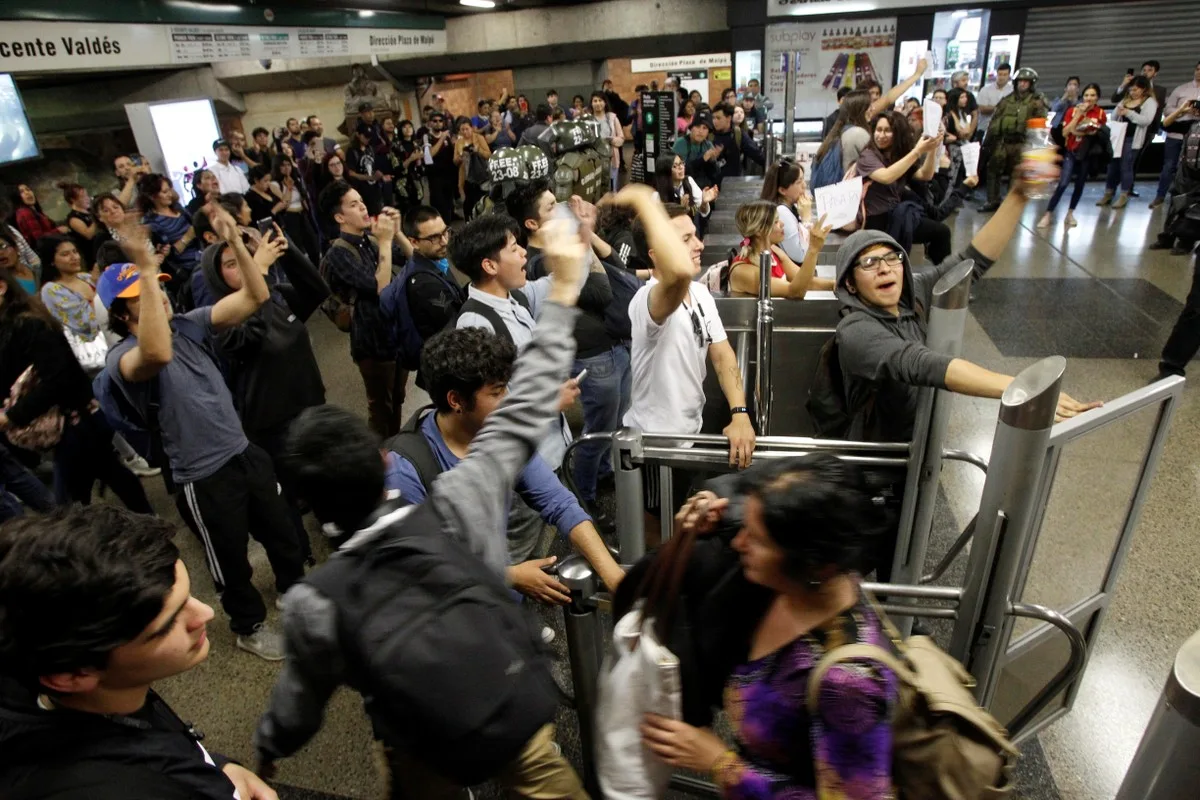
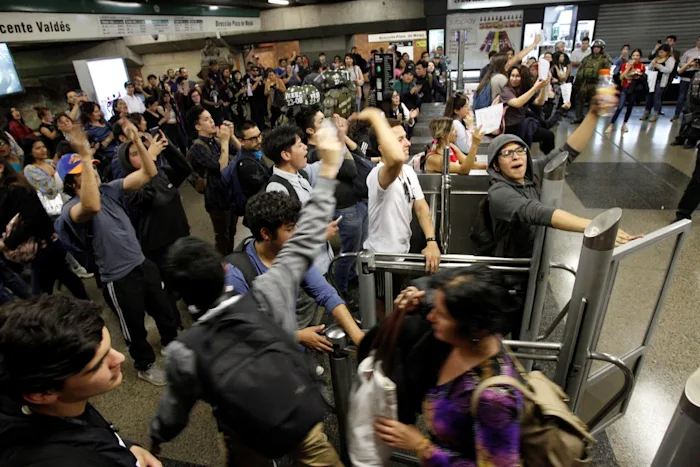
Let us be clear from the outset: there is no question of denying or avoiding social contradictions. Anyone can see that class domination and racial abjection constitute the structuring logic of suffering in this land. But how is an uprising against exploitation and abjection composed?
Mainstream political rationality has trained us to believe that the fate of uprisings depends upon the identity of the actors involved (students, black people, women, factory workers, migrants, etc.), since it is this that determines the radicality of "demands" the movement can imagine making, as well as the concessions sufficient to pacify it. Consequently (this thinking goes), only if the struggle is led by those whose demands are too radical for the system to accommodate can it ever hope to overcome the system itself. The problem of composition therefore appears, from this perspective, as reducible to the social content of the struggles. Who led? Who took control? Whose demands were centered? Did the middle class activists co-opt the movement? Did those whose social position ought to have compelled them to join end up staying away, and if so, how do we explain that? Much analysis of last summer focuses on the class and race identity of the participants, while comparatively less attention was paid to the grammar of action that drove it.
But what if we were to shift our focus for a moment away from the identity and "intentions" of the actors to the practices of the movement? What if the precondition for a revolution today lies not in the political consolidation and social command of a "leading identity" (the working class, the subaltern, the lumpen, the Native, Black, etc.), but rather in the contagion and ramification of leading gestures?2
Gestures don’t "lead" in the same way social groups were once thought to, i.e., by asserting historical or moral claims that would grant them the legitimacy to direct struggles. A gesture leads by (i) being copied and imitated, accumulating instances of repetition; (ii) by forcibly rearranging the field of intelligibility into which it is inserted, by changing the problem, such that neighboring practices must be rethought and reorganized in response to it, even if only temporarily; (iii) by facilitating other interventions around it, by “leaving, escaping, but while causing more escapes.”3 The mark of a leading gesture is that it becomes a vessel into which a broad swath of singular antagonists feel invited to pour their outrage, aggression, and ferocious joy. Coherence, resonance, and contagion measure the success of a decisive act.
Truckers angry about surveillance regulations get organized autonomously through Facebook groups and begin doing mass slow-rolls on freeways, blocking interstates and city centers. The gesture quickly spreads not only to other truckers, but also to locals who start showing up in their civilian vehicles for their own reasons, driving alongside the truckers, until it outstrips truckers entirely, leading to swarms of vehicles caravanning through city centers…
Police are filmed getting soaked by crowds of shrieking teens after attempting to disperse a water pistol fight. Within days, cops are being stalked and soaked by massive mobs of youth two states over...
Teenagers responding to fare hikes on public transit organize a subversive game they call “Mass Evasion,” which they promote on social media. The game adapts an everyday form of individual subversion — not paying for the train — transforming it into a collective gesture that groups can do together. State repression of the game only spreads it further and wider, catalyzing an insurrectionary sequence that is still unfinished to this day…
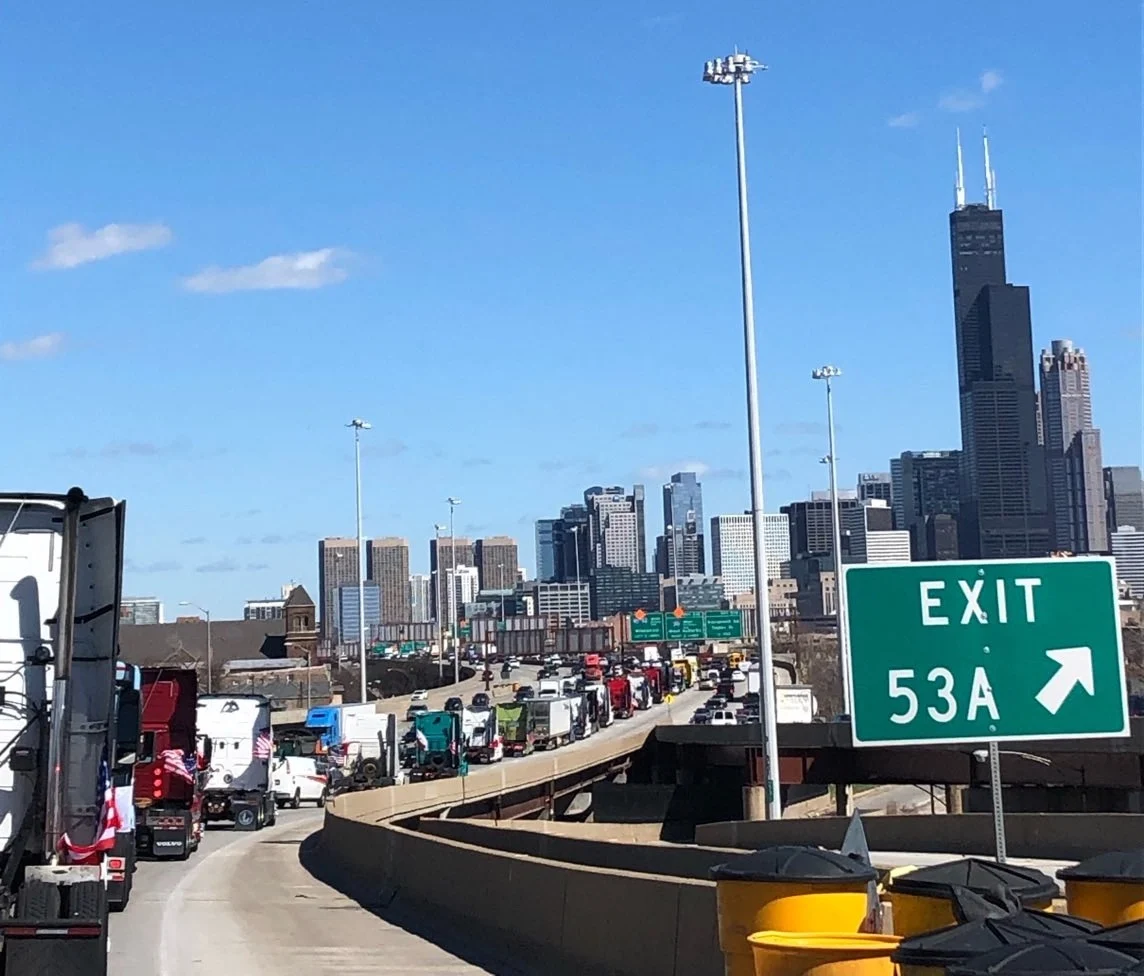
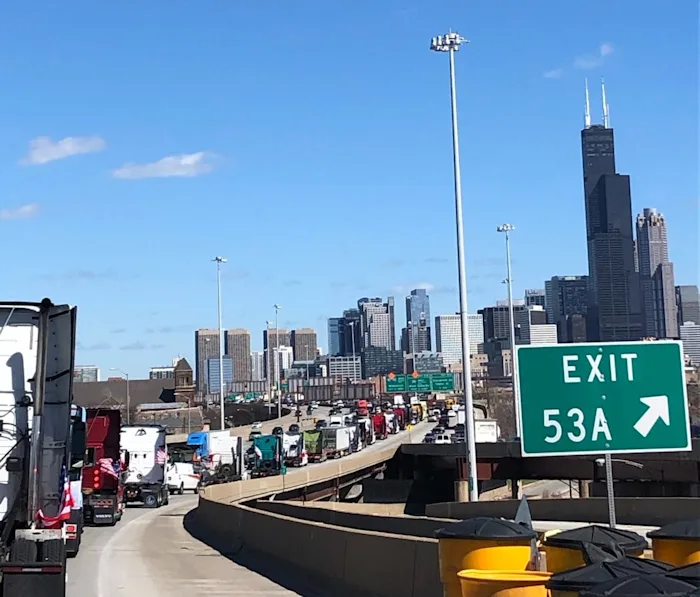
Just as it is meaningless to speak of “revolutionaries” outside of the revolutions they take part in, gestures are never liberatory per se but only as a function of the situation they intervene in. What matters is the space of play each opens up, their power to invite autonomous responses from onlookers (“yes, and…”), and the experiments that fill the space they open up as more people throw themselves in. The mark of a meme-with-force is that, before anyone realizes what’s happened, thousands of people suddenly feel authorized to take initiative and begin attacking the source of their suffering, starting from where they stand.
Both the Occupy movement of 2011 and the 2016 Labor Law movement in France (with its cortège de tête) consisted of a mix of memetic gestures and recognizably leftist and social movement grammar.4 However, the first mass uprising to explode entirely through a memetic platform was the Yellow Vests struggle in France. Here, it was the gesture of "putting on the vest" that placed one on a common plane with all others who have done the same. If memes can circulate beyond and across institutional and even national boundaries, this is not because they are somehow “universal.” On the contrary, memes are always seized upon for local reasons, even if these resonate with broader forms of social violence (austerity, atomization, abjection, etc.). Unlike political organizations, which generate consistency by translating singular experiences of violence into shared ideologies, one can put on a yellow vest and show up at a traffic circle and remain a singularity. Whereas one “belongs” to a political organization by joining it, we join ourselves to gestures only by repeating them, introducing variations into them. However, the difference concerns not only who and how one ‘belongs’, but also how one fights. Whereas the tendency of the social movement is to articulate conflicts in terms of demands made of this or that institution — tuition, work benefits, papers, etc. — a meme-with-force does not come with a readymade set of demands, nor must we belong to any certain social group in order to gain entry into it. Since there are few preliminaries, prerequisites, or preconditions, memes allow individuals to move alongside one another while preserving their own respective reasons for fighting, thereby inviting each of us to trust in our own singular evaluation of the situation. This has the great advantage of allowing memetic movements to harness and leverage the ante-political5 forms of life in which each of us already participate: think of the hooligans and ultras who fought in Turkey’s Gezi Park uprising, the mutual aid networks and autonomous hubs that fed into frontliner formations, or the motorcycle clubs and sideshow drivers whose revving engines became a permanent sensory feature of the George Floyd uprising. When conflicts kick off, these ante-political lifeforms suddenly become potentiated in new ways, they bend, criss-cross and weave together like so many shards of light through the kaleidoscope of the event, adding fuel to the fire. When a fighting force is assembled in this way, it can grow and multiply along paths that are responsive to the really existing terrain of the situation, rather than relying on obsolete rituals handed down by the institutional left. And since there is no distinct subject whose “interests” can be appeased or bought off in order to quell the escalation, no expiration of hostilities is programmed into the movement in advance.6 Although it always meets its limits in reality, at a formal level memetic antagonisms are limitless, since they have no reconciliatory horizon.
This tight link between memes and ante-political forms ensures that politics remains connected to our intimate everyday life, which it also weaponizes. At the same time, it belongs to the nature of all memes to be wrenched out of their context and away from their creators, since anyone can pick them up and pull them in another direction.7 Memetics lodges itself within this tensor between intimacy and anonymity, between banality and contagion: its locus lies in the switching-point where life becomes combat, where non-political practices and cultures such as singing “Baby Shark” to an anxious toddler, jumping subway turnstiles, or carrying an umbrella in Hong Kong suddenly become magnetic and find themselves incorporated like machine parts into combative formations. The real secret, the one that Western ideology has always worked to conceal, is that there is no separation between “politics” on the one hand and “life” on the other. There is only a single flat surface — experience, everyday life — articulated into various grammars of suffering and populated by countless ante-political forms that here and there reach a threshold of intensity that polarizes them, often (but not always) under the sway of larger events.8 What matters is identifying, in this or that situation, how unowned, inappropriable, anonymous practices originating in everyday life become magnetized by conflicts, and what potential reach each might still pack within it.
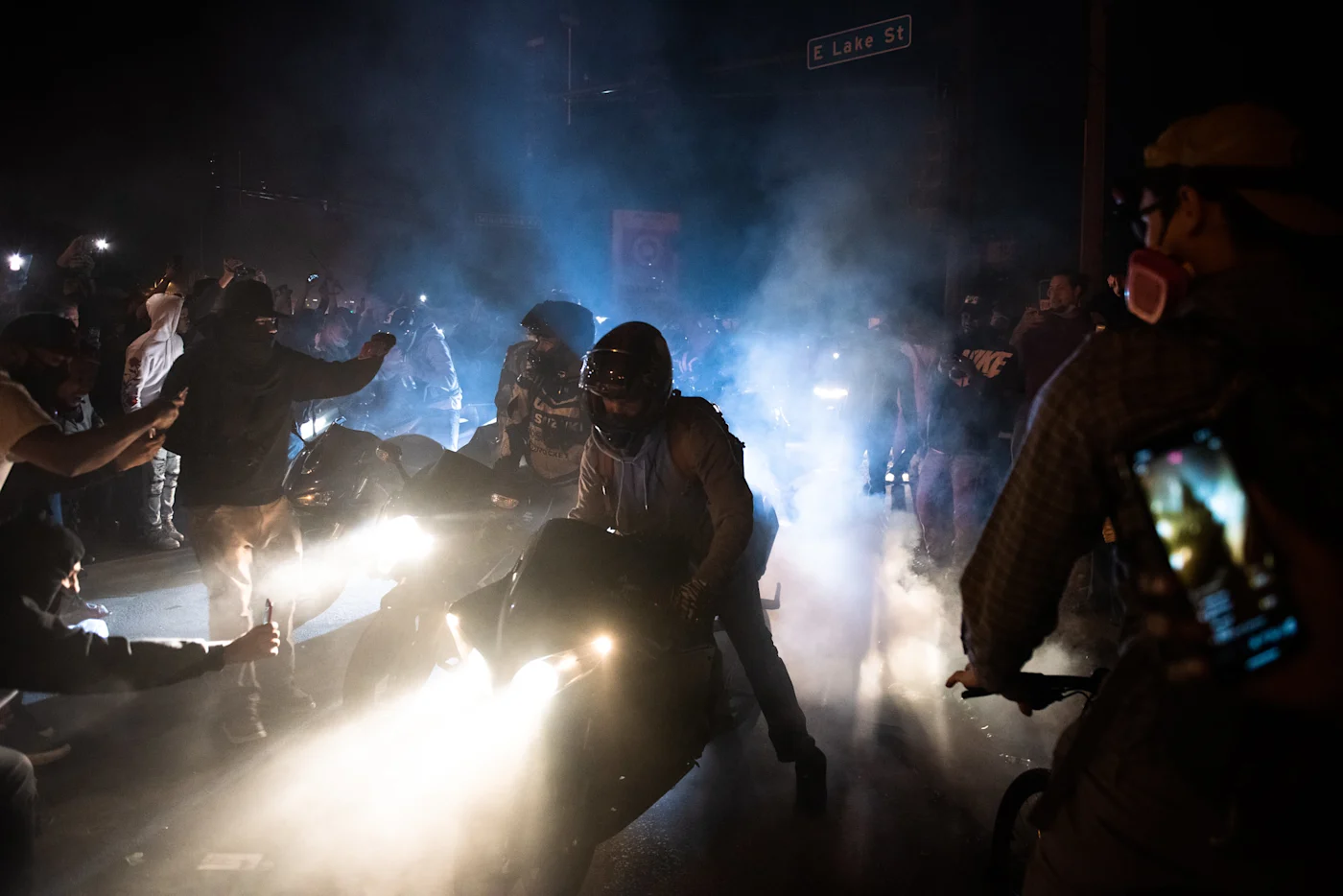

While it is difficult to imagine an insurrection in the USA today taking the form of a disciplined consolidation of marginal social groups — e.g. in a crystallization of crowds into "classes" through solidarity, or by forming new racially separatist militant cadres9 — it is considerably easier to imagine a viral contagion of actions that respond intelligently to their moment escalating into mass experiments in communist sharing on a variety of scales. Whether these approach the horizon of becoming an insurrection will depend on whether such experiments are sufficiently empowering in material and ethical ways to render the return of normal life and bourgeois economics undesirable for millions of people.
While there is nothing wrong with paying attention to, and even participating in social movements organized around institutional or identitarian demands, we should not see them as terrains of victory on their own right, but as laboratories for new memes-with-force. From this angle, the aim of insurgents within social movements is to propagate memes across them, like anonymous viruses on a hostile platform. The black bloc was one such virus. The car caravan was another. The plaza occupation — a tactic now approaching its exhaustion, at least in North America — was a third. What forms of action constitute the cutting-edge of what’s thinkable today? What minor gestures have already emerged, but missed their chance to spread?
Open the vortex, extend the meme, to the point of ungovernability.10 Repeat, expand, innovate. Do what you can to ensure that the movement stays inviting and open to new and wider groups of people. Try to prevent any group from ideologically hegemonizing it — not only the far right, but also the far left.11 Only in this way can we generate the conditions in which mass experiments in living outside of the rule of money, measure, and racial abjection might take root.
The party is not its ends but its gestures. It is only as it does. And — like substance for Spinoza — it always goes as far as it can.
Demolition / abolition
The first phase of the George Floyd rebellion was qualitatively different from the policy-friendly social movement that later strove to supplant it. The spontaneous practical intuition of the crowd signaled an entirely logical response to the forces that murdered George Floyd: push the police out, sabotage their bases, sink their battleships. Destroy the places from which their violence is organized — precincts, substations, courthouses — as well as the cars and vans that circulate it. By contrast with the abolitionist campaigns to “defund” police departments or (in its weaker versions) to supplement them with “civilian review boards” — discursive, dialogical, and demand-based frameworks that leave the initiative in the hands of the state — demolitionism aims to materially flatten the organs of state power, to make it logistically and socially impossible for the police and courts to assert their claim to rule; in short, to render the situation ungovernable, and to make this fact flagrant for all to see. It was demolitionist practice and not abolitionist policy that burned the Third Precinct. And what of the pillage of several hundred businesses that accompanied this historic feat? It is important to recall that looting is not simply an attack on the commodity form, or a renegade form of consumerism. It is also the most direct way possible for a crowd to concretize, exhibit, and feel the power it has wrenched away from the state and its police, to make this power real, to fulfill it. No activity more directly confirms the absence of police control over a territory, the suspension and inoperativity of the law than looting.12
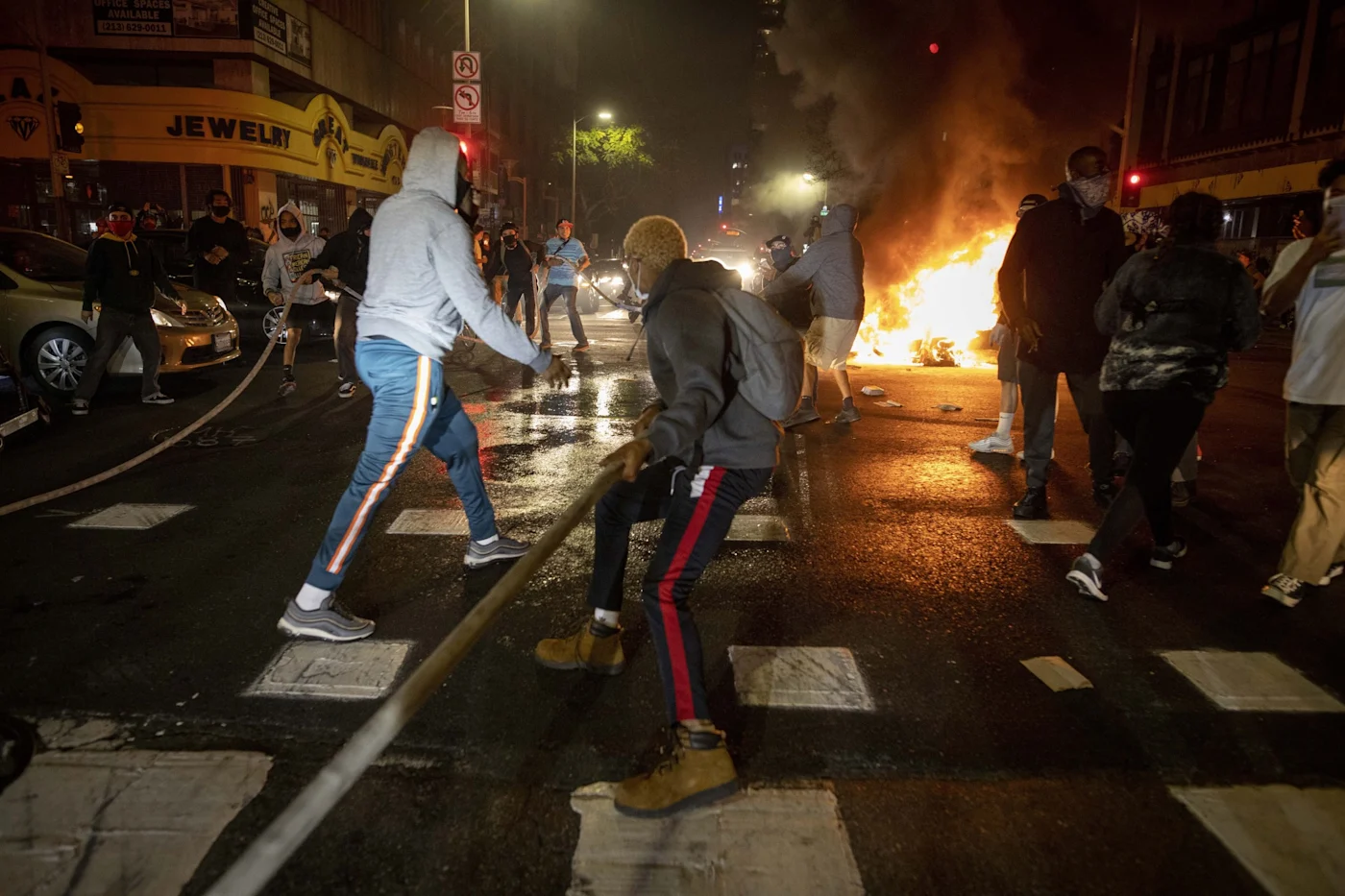
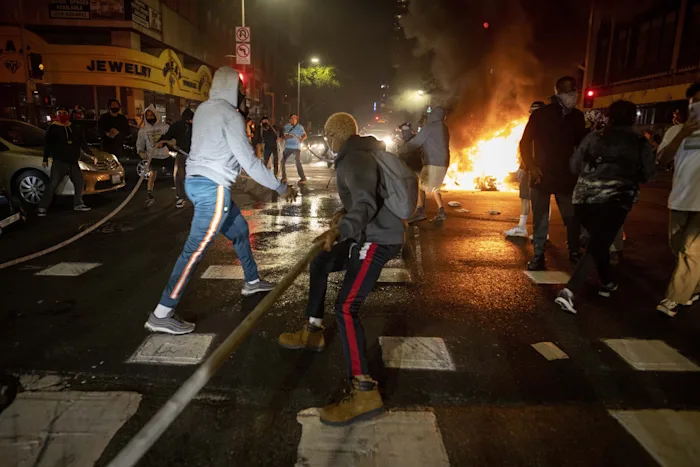
That the burning of the police precinct was a meme was evident to anyone paying attention during the first few days of the revolt. No sooner was the Third Precinct burned than the crowds in Minneapolis spontaneously attempted to torch another one. Similar efforts took place in other cities, including Brooklyn, Reno, Portland, and elsewhere. On May 29th, 2020 in Minneapolis, a fierce battle took place over the Fifth Precinct. As happened with the Third, police took to the roof, using flash-bangs and rubber bullets to hold the crowd at bay. That the crowd intended to repeat its successes from days prior was evinced not only by the chain of businesses and government buildings set ablaze across the street and all down the block, but more immediately by the Molotov cocktails hurled against the outer walls of the precinct itself. While it is difficult to know for certain, it’s quite possible that the Fifth Precinct was in fact evacuated during the conflict, as police formed a line in the street and pushed the crowd back into a nearby strip mall under a barrage of chemical munitions and flash-bang grenades. Although the crowd made a valiant final push back toward the Precinct, it was ultimately unable to disperse the police line before the National Guard stepped in. The battle for a second precinct was fought, and lost. The logical task of the movement could not be continued.
The next major opportunity to continue the meme was in Seattle. Although there were elements in the crowd who pushed for burning the precinct after the police withdrew, a combination of paranoid fantasies and arbitrary forced choices (destruction or occupation, etc.) ultimately succeeded in deterring them. As a result, what occurred instead was a reversion to the familiar leftist tactic of outdoor occupations popularized during Occupy and more recent anti-ICE protests.13 From the moment Seattle failed to reproduce the meme of burning precincts, this first phase of the rebellion ended. Other towns would come close: courthouses were briefly set ablaze in Oakland, Portland, Nashville, and Seattle; construction buildings at the site of a new youth detention center were torched in Seattle — yet all fell short of the bar set by Minneapolis.14 It was not until the eruptions in Colombia and Nigeria that the Minnesotan attack on police infrastructure would be successfully memetically reproduced, and the bar raised once again.
As was noted elsewhere, the calibration between sense and gesture is a dynamic and fluid one. In some struggles the slogans, ideas, and thought falls short of the tactics and gestures that we’re engaging in, and we find ourselves demanding things we already possess, or framing things through terms or oppositions that the movement has already surpassed at a practical level. Other times, thought runs ahead of the tactical repertoire, such that every effort to elaborate a practice appropriate to the affective declension of hostilities and the ideas in peoples’ heads seems to fall short. When the George Floyd rebellion failed to develop its central meme, the ensuing absence of a horizon opened the way for a social movement apparatus to insert itself into the confusion and redraw the stakes of the conflict.15
Race treason and the real movement
Considered from the outside, the George Floyd rebellion appears as a historically aberrant "coalition" between socially contraposed identities. While this language makes sense from a certain sociological perspective, the limitation of this point of view is that, if one was white-skinned and went hard in the George Floyd rebellion, one can articulate this experience only negatively, as the position of the "race traitor," but not positively. Since it interprets actions exclusively through their subjective positions within the structure or diagram of the racial caste system, the rhetoric of race treason grasps the situation correctly yet externally, from the side of governance. Meanwhile, the phenomenology of race treason — i.e., the description of this subversion from within — remains unwritten.
Nothing is more intimately real than moving in an anonymous mob alongside one another, pulled like moths toward the flame. To describe the experience of last summer’s rioting as “treason” is to read it only through the "ban" that structures the anti-Black civil society it left behind, while passing over in silence the penchant that it abandons itself to. When we consider things internally, what could appear from the outside only as a betrayal of hegemonic norms often feels like quite the opposite. From the inside, it felt like the recovery of a type of qualitative experience that racialized bourgeois society has starved us of: a luminous and confident presence to a shared situation, rich with practical stakes, shared risks and mutual dependencies. An opportunity to express our non-belonging to the dominant historical order. Before we can betray our ascriptive identities, we must first put an end to that treason to ourselves, that ceaseless betrayal and mutilation of our senses demanded of us by the “sensory religion” of Empire.16 Whereas "race treason" looks upon this moment from the outside, from an internal or modal perspective — a perspective focused on the grammar of action and experience of presence — we will speak instead of the real movement.
Any integral understanding of political events like looting and fighting the police must also account for the restoration of experience that first makes such attacks possible, a restoration of an ethical nature. By "real movement" I refer not only to a specific repertoire of methods and gestures but also to the restoration of confidence these presuppose, a certain presence to the world within us to which they attest. Every uprising is first of all an explosion of vital confidence in our own perceptions, a sudden willingness to take our own lives seriously as the site and source of "legitimate" truth. The riots last summer would never have happened without a singularization of this sort, in which we refuse to decouple ourselves from our own perception, from our contact with the world. Before it can set out to demolish the present state of things, the real movement first coincides with the messianic assumption of our singular entry into the world: the suppression of mediations, the end of waiting, the moment we stop asking for permission or dialoguing and start doing what makes sense to us for our own reasons. “As one wise vandal sprayed-painted on a wall in Minneapolis: ‘Welcome back to the world.’”17
This internal ethical movement is reflected in the grammar of action of the riot. During the first week of conflict last summer (but also in the explosion in Kenosha, the resurgence of looting in August in Chicago, in Philly after Walter Wallace was murdered, etc.) there was a radical absence of classical discursive political practices. Hardly anyone bothered identifying or subjectivizing themselves, there was virtually no formal or informal dialogue with the state, nor were decisions vetted through assemblies, town hall meetings, or other quasi-democratic forms. By contrast with the amputated speech that characterizes Western classical politics, wherein citizens come together to debate ideas in a space formally separate from the domain of everyday life, when people wanted to say something they wrote it with spray paint on the windows and walls of businesses and state property. This linkage of thought and gesture typifies the real movement. We might even say that the real movement begins the moment people stop looking for some external source to legitimize their actions and instead begin trusting in and acting upon their own sensibilities, their own perception of what makes sense versus what is intolerable. From this moment forward, the whole apparatus of official politics begins to collapse, allowing everyone to see it as the managerial hell it is.
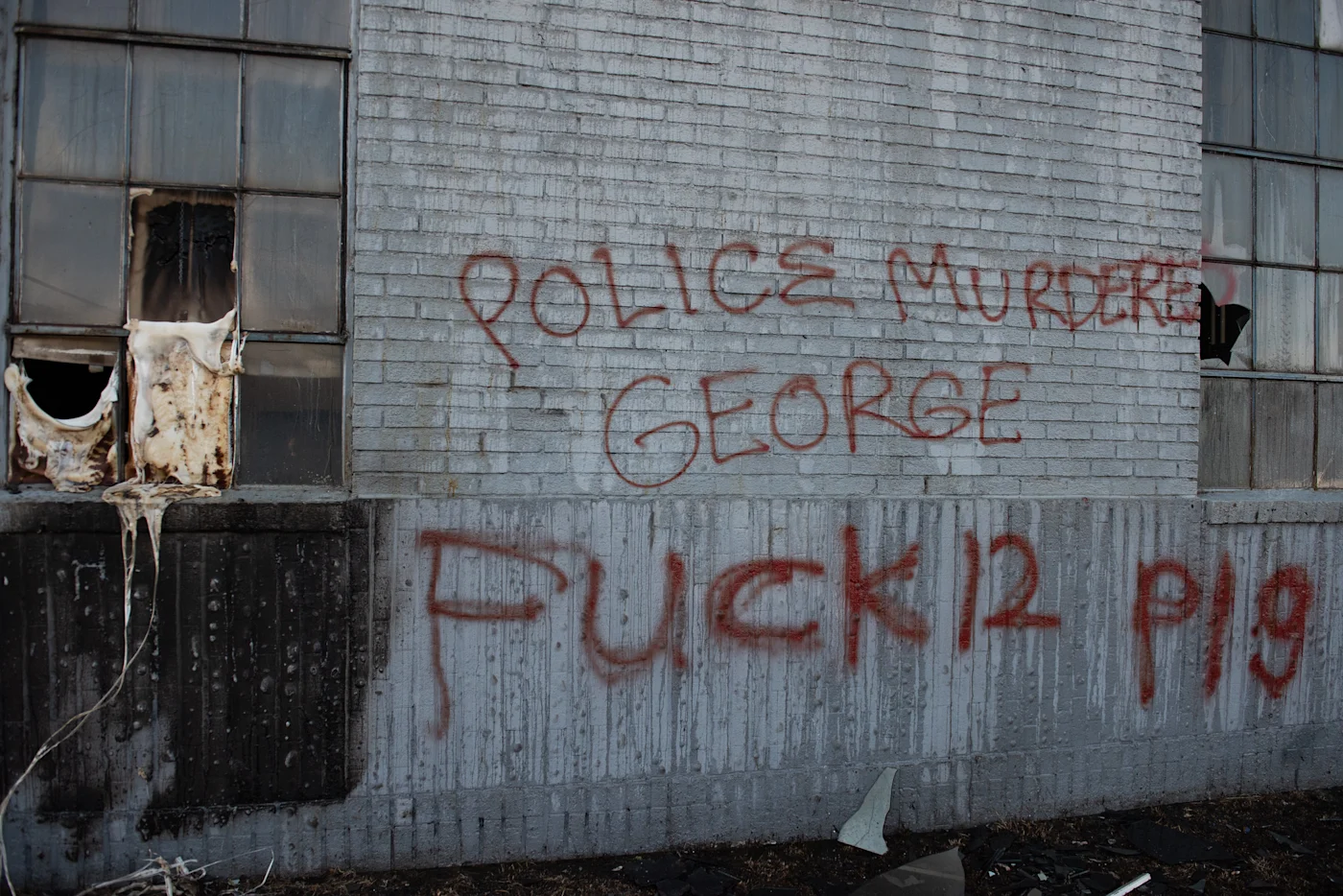
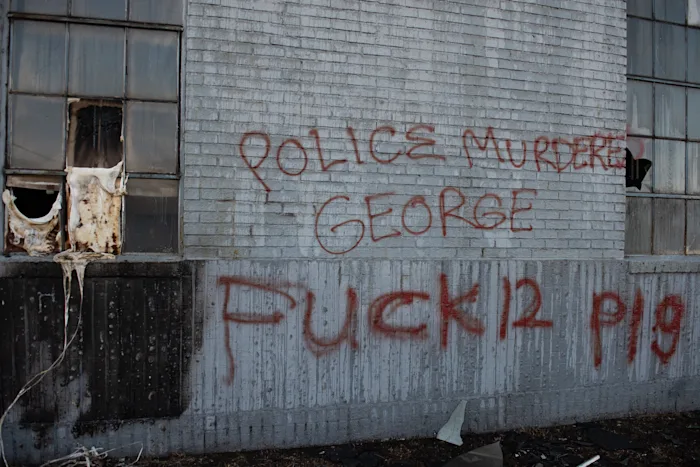
To the extent that the real movement signals an exit from the apparatus of classical politics, we might be tempted to speak here of an “anti-movement” or a movement of “antipolitics.” However, the negativity of such formulations would be misleading.18 What is in question is a positive liberation of conflictual action from established rules and customs, a departure from the constituent logocentric “game” in which politics discovers its consistency in discourse, opinions and ideological programs, and the replacement of this game by another.19 As Blanchot knew in his day, any “rupture with the powers that be...with all the places power predominates” must also be a rupture with “a speech that teaches, that leads, and perhaps [with] all speech.” However, as he was quick to insist, this “is not merely a negative moment” but must be understood as a “refusal that affirms, releasing or maintaining an affirmation that does not come to any arrangement but that undoes arrangements, even its own, since it is related to dis-arrangement or disarray or even the nonstructurable.”20 Hannah Black put it nicely: “communism is a movement away from the state and toward each other. Everything that happens in the street is a lesson because it is a point of contact.”21
However, what there is of community in the real movement is not easily named or identified in a positive sense from without. To speak of a fidelity to one’s penchants, or of an end to self-treason is not yet to speak positively of community with others. To conjure up a new political subject or "species" (“the George Floyd rebel”) as some friends have done only avoids the issue without solving it. It is not an accident or an oversight that America has no language by which it could describe race treason internally. Perhaps the problem should actually be reversed: whereas racialization has its origins in a triangular diagram that articulates the humanity of full and partial subjects through the abjection of a third non-subject position (more on this below), race treason in the Americas belongs within a long lineage of desertion and opacity that affirmatively refuses to appear on the map of dominant history. From the lost colony of Croatan to the Lowry Wars, from Bacon’s rebellion to the Free State of Jones, a powerful yet subterranean history of racial defection and anonymous secession has punctuated American politics since it began.22 As Kiersten Solt is right to insist, “contrary to every spectacular perspective, the relation between revolutionary elements and their would-be representatives is that of a persistent and asymmetrical conflict.”23 Whether the offer on the table from civil society looked like membership in a failing English plantation economy or entrepreneurial inclusion in the beautiful hell of a racialized late capitalist spectacle, the primary, raw fact of the real communist movement in this country has always responded to a single formula: recovery of experience = decomposition of the social; the commune in / as the desertion of the social experience we are offered. The communication experienced during last summer’s riots belongs within this lineage: it was “a movement of contestation that, coming from the subject, devastates it, but has as a deeper origin the relationship with the other which is community itself.”24 As Keno Evol observes, to assemble a fighting force is always also to assemble “relations of sustained regard” that, we must add, always remain illegible to the spectacular order.25
The social movement apparatus
How was the George Floyd rebellion defeated? Sixty years ago, an expert in the theory of counterinsurgency warfare distilled the basic strategy into a lapidary formula: the task of counterinsurgency is "[to] build (or rebuild) a political machine from the population upward."26 When taken to heart, this formula offers a fresh perspective on the repression of the George Floyd movement last summer.
The pacification of the revolt did not occur solely or even primarily through flash-bangs and tear gas, but by waging a war over the meaning of the war itself. In response to its messianic self-authorization, the forces of order not only attempt to frontally “crush” the most intense and threatening forms of rupture and rebellion from outside, but also deploy “soft” modes of capture and displacement designed to ratchet down the stakes of conflict by translating the conflict into a social movement. This apparatus of translation-pacification of the real movement may be referred to as the social movement apparatus.
As Laurent Jeanpierre reminds us, even when they oppose the official institutions of society, social movements “are institutions themselves, since they depend upon legal rules and customs, rules for the game of contestation.”27 In 2014, state media, the left, and the police crushed the Ferguson revolt not only by gassing, beating and arresting insurgents in the street, but also by canalizing the rebellion itself into the framework of leftist politics (Black Lives Matter™). Today, the campaign around “defund” plays a similar role.28 The operation is always the same: jam the rebellion into a watered down and sanctioned form of dialogue between recognized constituents, marginalize and criminalize any grammar of action or form of communication that doesn’t fit within it. That the apparatus leverages both existing institutional influence as well as moderately disruptive protests should not mislead us as to its essential meaning, which consists in neutralizing and pacifying the joyful collective confidence that the rebellion instilled in thousands of angry people. By displacing the terms of confrontation from a demolitionist wave to abolitionist demands the social movement apparatus alters the terms of conflict, redirecting the wild, unmediated forms of cooperation, rebellion, and action that initiated the rebellion back into recognizable dialogical grammar of politics, the better to manage them and pacify them.
Moreover, while it is customary to associate the term “social movement” with a contestation of state or economic power (whether from the left or the right), dominant institutions also spontaneously adopt its forms when their legitimacy is challenged. We see this both at a superficial level, when police and private property mobilize victimhood structures to shore up their own discredit, but also at a deeper level that penetrates to the very core of the racial matrix in this land.
Locals may recall a farcical moment in 2017 when, after losing control of downtown St. Louis to riotous demonstrators for over an hour, the cops who retook control felt the need to chant in unison, “Whose streets? Our streets!" The next night, the police union headquarters had its windows smashed out, its walls graffitied, and its police service vehicles vandalized. The union responded by posting a sign on their door declaring, "We are open. We won't be defeated.” A union spokesperson told the press that day that the vandals were "trying to intimidate us," that they had "declared war on us” — and in fact, police in this country have unceasingly complained of suffering “hate” at the hands of the public ever since. How many times last summer did cops “take a knee” like Colin Kaepernick? It’s not just the police either. When businesses write “minority owned” on their windows in the hopes that they’ll escape being looted and torched, we see a similar logic at play: the petty bourgeoisie, seeing that the regime of property is being called into question, translates its claim to ownership into the identity politics of the anti-oppression social movement. In both cases, it’s as if a wounded social-institutional structure, noticing that its legitimacy is in the gutter, suddenly began speaking no longer in the majoritarian voice of juridical society but rather as one organized clique or faction among others. By taking over protest chants and poster-slogans, the forms of social domination spontaneously adopt the social movement form in order to reassert their credibility.
At a deeper level, however, if the racial order in this continent cannot be overthrown by means of a social movement, this is because it was originally produced by one. The structuring racial diagram of the Americas does not begin in Port Comfort, Virginia in 1619; it was forged exactly 100 years earlier, as a plea to address the suffering of the (part civilized, part savage) "Indian," to which the enslavement of Africans offered a solution.29 The proposal to import slaves en masse from Portugal to the Americas was among the first fruits of a nascent decolonial rationality when, in his 1520 audience with the crown, the great “Protector of the Indians” Bartholomé de Las Casas proposed replacing the recalcitrant and rapidly-dwindling labor supply of native populations with Africans, a group he believed to be "better suited" to a lifetime of back-breaking toil and social death.30 It was through Las Casas’ civilizing gesture that anti-Blackness entered America, by distinguishing rightful claimants to the mantle of civilization (its junior partners) from those who never can nor will find a place in it, because they do not appear on its ‘anthropological map’. The civilizational analogy between the Settler and the Native that Las Casas mobilized in his struggle to guarantee recognition for the ‘Indians’ within the universal community of Humanity was founded both economically and ontologically on the fungibility of the African slave. In other words, when anti-blackness first sailed to the Americas, it did so under the indemnifying flag of respectability politics.
The racial order of the "New World" was a binary machine (civilized/savage) only for approximately thirty years; from the 1520s onward it became a ternary structure (major/minor/non-subject). Its signature was forged by a decolonial anti-racism that understood that, for the "Indians" to become junior partners to Western civilization, the unchallenged enslavement of Africans was necessary. Of course, the half century Las Casas spent pleading his case to the Empire did little to halt the genocide of Native Americans. It did, however, serve to install a triangular social apparatus that remains with us today. It is only an apparent irony that Las Casas, “the man often pilloried for advocating, hypocritically, the initiation of the African slave trade” would later be regarded as “one of the philosophical and spiritual progenitors of the abolitionist movement that sprang to life a century and a half after he died.”31 After living through last summer, the irony dissipates. In his moralism, in his pseudo-universalism, in the naiveté of his faith in Christian values and in the conscience of the ruling class, Las Casas remains the disavowed father of Western leftism avant la lettre. The fact that the institution of anti-black slavery crossed the Atlantic passage co-signed by a salvific humanitarian gesture offers a pertinent reminder that the West is a civilization that can save with its left hand only by relegating others to the whip with its right.
This insight also offers a clue about how (and how not) to fight. The ultimate function of the ternary racial diagram was not merely to legitimize the rapine and enslavement of non-European life, it was also a desperate effort to patch the dangerous cracks in its own ruling fiction: the fiction of unitary civilization per se. In order to defend the universality of Christendom’s claim to absolute truth against the major anthropological crisis that menaced it from without — “the possibility of multiple true worlds”32 — but also already from within in the form of an unruly peasantry — a liminal figure was needed. As Ronald Judy has shown, if the Indians were deemed not "irrational" but unrational in the manner of children, this was because assigning them the status of "potentially civilized" allowed European ideology to internalize and defang the threat they signaled to its order, relegating it to a harmless alterity. By straddling the gap between inside and the outside, reason and unreason, the racialized junior partner allows civilizational epistemology to position itself both inside and outside of its own order, and thereby to master its edges. It is by becoming the principle of both itself and its other, by making its actuality the destiny of all potentiality, by learning to anticipate forces of subversion and grant them a (subordinate) place in its world that humanism becomes the governing paradigm of the social. “The moment in Western history when the recognition of alternative worlds becomes possible — in the Spanish encounter with the Aztecs — is also the moment when humanism achieves hegemony.”33
The result, as Frank B. Wilderson has shown, is an ethical ambivalence that becomes foundational for modernity: do we imagine emancipation in terms of the analogy between “savage” and “settler,” and organize ourselves through claims to sovereignty, humanity, inclusion and recognition (the social movement)?34 Or — and this sets up the legacy of race treason in the USA — does one pursue a paradigmatic alliance with blackness, and desert the project of Western humanism? It is a decision that must be made not only by Native Americans and Jews, whose grammar of suffering leaves them suspended between genocidal dis-location and junior sovereignty, but everyone else too. Those who are not Native must also decide whether to “adjust their logic” to fit that of genocidal ontology, or to make their peace with anti-Blackness.35 However, whereas Wilderson reads this possibility exclusively through worldlessness and ontological death, Judy’s insistence on racialization as a response to the “possibility of multiple true worlds” opens up another path: whereas the social movement inherits the civilizational project of internalizing all exteriority and alterity through partial inclusions, while blackening that which it cannot digest, race treason seeks not inclusion but to explode the fiction of a unified society itself, by allowing the multiplicity of worlds and forms of life it crushed under its weight to burst forth.
The recent rehabilitation of “vitalist” thought in North America could perhaps be understood from a similar perspective: less an import of European communist thought than a continuation of the American legacy of secessionist race treason. Once wrenched away from the jaws of the spiritualist far-right36, an affective idea of life can help draw attention to the vital multiplicity that rumbles pitilessly beneath the surface of civilization’s unitary façade, undermining the latter's claim to include all subjects actual and potential. For instance, applying this insight to the George Floyd rebellion, H. Bolin and Sonali Gupta describe the virality of its combatant crowds as “a mode of contagion that destabilizes the way constituted groups interface with one another, confusing their position within the established order, which prepares the ground on which destituent powers can emerge.”37
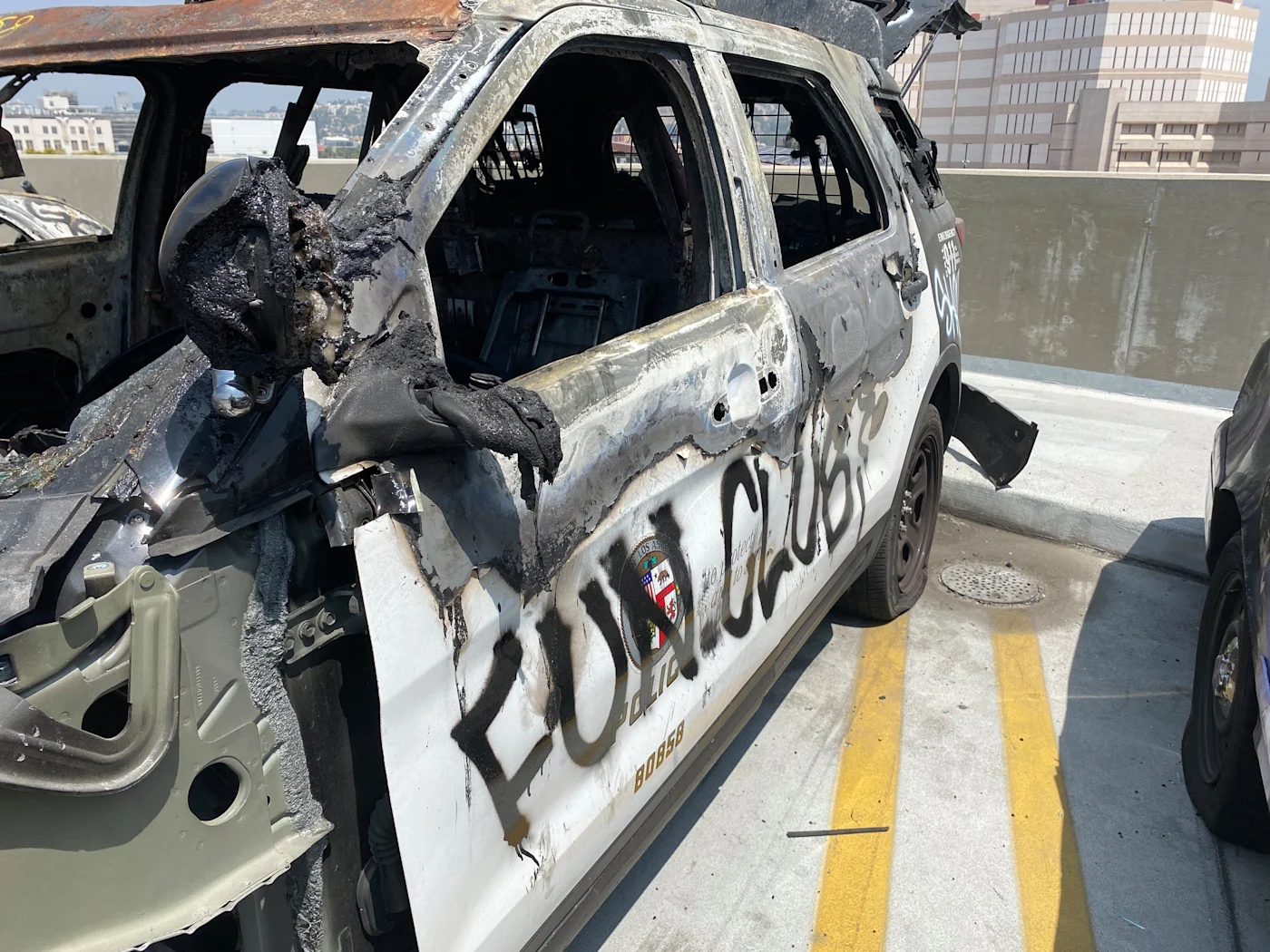
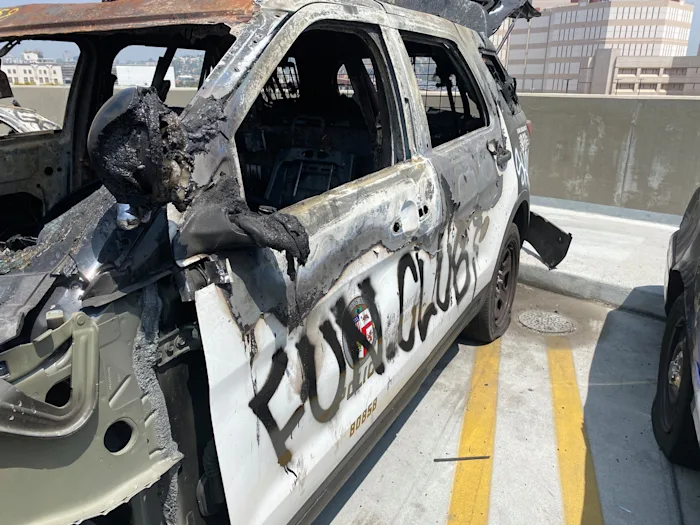
Neo-abolitionist approaches to decarceration and “non-reformist reforms” beginning in the 1980s were intended to serve as a combative intervention against the carceral leftism of their day, by helping to “imagine the possibility of shrinking the prison-industrial complex and ending reliance on imprisonment.” However, with the return of the real movement, abolitionists now face a stark choice: hold onto the strategy of “non-reformist reformist” policy or accept the strategy of demolition-as-abolition, developed in response to George Floyd’s murder. If abolitionism’s line of flight has now been captured, in order for it to produce new escapes — into the real movement — it is necessary to break the frame.
Just as the real movement can be captured and canalized into the social movement, social movement formations can undergo becomings that place them in contact with the real movement, allowing them to outstrip their managerial frameworks. This is what happened to the Loi Travail movement the moment the cortège de tête flipped it into a meme. This is what happened for two months to the established BLM organizations in Chicago last summer, once they allowed themselves to be swept into a physical confrontation with the police and a taboo embrace of imprisoned looters. It is what happened in Portland’s “frontliner culture,” as new and varied groups of people began showing up at the Justice Center in gas masks and hockey gear spoiling for a fight. As often happens, many of these becomings eventually became blocked, routed, or trapped within a resurgent activist consciousness. But these defections and recompositions were real desubjectifications and desertions in their moment.
We must neither abandon nor embrace social movements; rather, we must explode their frame, cause them to break away, force them to encounter their outside and keep them in contact with it. In short, we must place them into flight. What we want is both more and less than a social movement: more antagonistic than an institutional framework will ever be able to express — more contagious, more viral, more complex and capable of absorbing becomings, mutations, self-destructions and rebirths of subjects, and not simply “recognition” of their existing demands — but also less than a social movement, since we don’t always want to have to “appear” to one another or to power as a social entity, we don’t want to play the games of language, dialogue, critique and negotiation. We’re tired of games whose playing field is stacked against us from the start.
The anthropologist Pierres Clastres defined primitive or “classless” societies by the techniques they develop internally to hold the state function in abeyance. In a similar spirit, today we should seek to identify those features and dimensions of struggles that succeed in warding off capture not simply by the state but also by the social movement apparatus. This is, once again, why some of us have begun to theorize revolt and communist potentialities through the framework of partisan memetics. Memes invite us to take our own singular perception seriously, since they call us to answer them, to repeat them, according to the contours of our own life, our own situation, to respond in ways that reverberate with our bodies, while undermining the rigid separations through which the racial order governs our separation. Yet, in and of itself, this is not enough to put us on a long-term revolutionary timeline. Memes alone cannot offer us a living form in terms of which we can exist together with others in a long term way, a shared world to inhabit. What they can do is place the social movement apparatus in flight, break its frame, refuse its discursive and representational interpellation, its episodic temporality, and suppress its tendency to adopt governmental subject-forms as its practical language. But they are not enough to escape the cycles of recuperation, capture, and burnout, nor do they provide a soil in which to plant ourselves in the long term. The meme is a moving train. In the long run, we need to plant roots on something slightly more stable.
Unlike during the Yellow Vests, whose implantation on the roundabouts shifted the site of the political to bases situated in an extreme proximity to everyday life, which they filtered through the collective blockades and cabins they constructed, efforts to territorialize the George Floyd rebellion met with mixed and often disappointing results. From CHAZ in Seattle to the armed paranoia of the Wendy’s no-cop zone in Atlanta, the experiments in placemaking — although too locally heterogeneous to be subsumed under any consistent patterns — generally failed to establish lasting consistencies that point beyond the suspended time of the battle. The horizon of the George Floyd rebellion remained, for better or for worse, the horizon of the riot, and once its offensive capacities were throttled the real movement had no other possibility but to recede.
Political riot and storefront riot
The movement’s offensive capacities, as well as its imagination of its own power, were distributed across two distinct dynamisms. On the one hand, political riots target the symbols and halls of state power (city halls, courthouses, police precincts, monuments and statues, but also the media); on the other hand, storefront riots target merchandise, from big box stores and banks all the way down to 7-11, cell phone shops, Gamestops, etc. Whereas the political riot generally consists in a stationary geography in which crowds attempt to beat back police lines and, if possible, sink the enemy’s battleship, the merchandise riot is defined by a mobile crowd in flight from the police. While the two riots might occur on the same day, or even within the same approximate space (as in Minneapolis), they are distinguished not only by their selection of targets but by the affective dynamism that organizes the crowd: are we moving forward or backwards, toward or away? Is the aim to attack and disperse the police, or evade them as long as possible, while consummating our momentary independence? Whereas the siege mentality of a political riot depends upon the sustained conflict with personnel outside highly symbolic sites of state power (e.g. the Justice Center in Portland), in the merchandise riot the experience of collective power is felt through the maelstrom of vandalism, looting, and arson along its flight path.38
Generally, the pattern is for political riots to mutate into storefront riots when crowds are driven away from state targets.39 Sometimes, the mobile crowd may encounter state property along the way, as happened when the Bureau of Corrections building was torched in Kenosha on the second night, but this does not fundamentally challenge the dynamic difference at play in the two riots. This difference is the kernel of truth of that cynical lie by the state when it attempts, as part of its divide and conquer strategy, to drive a wedge between “good” and “bad rioters.” In point of fact, the two crowds were already divided, even if neither can be reduced to “pure crime” as the state sought to do.40
The combination of these two vectors resulted in a wave of material devastation surpassing any North American rebellion in the 20th century. Between May 26th and June 8th alone, an estimated $1-2 billion dollars in damages were recorded, with mobilizations taking place in some 1700 cities and towns.
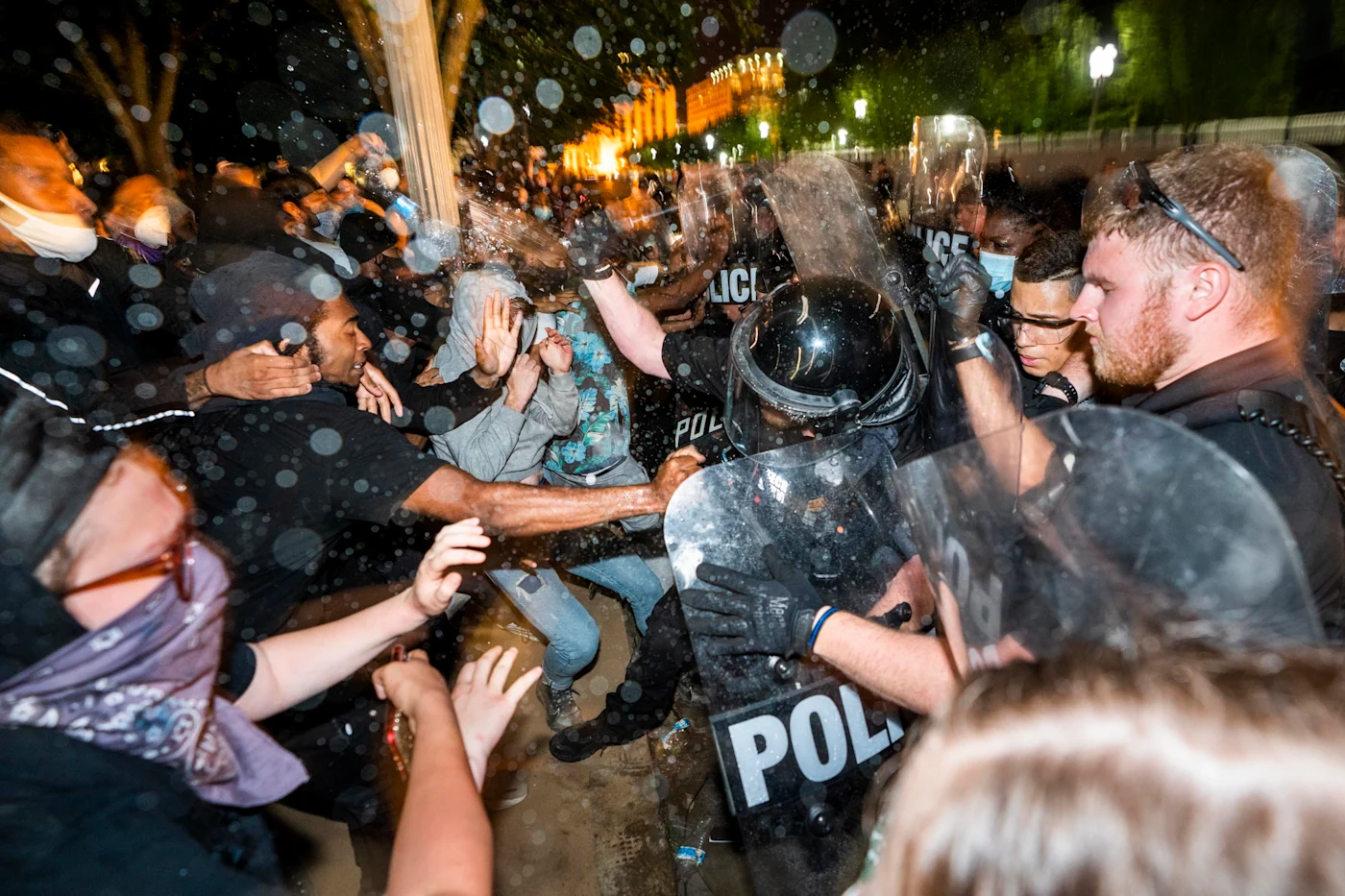
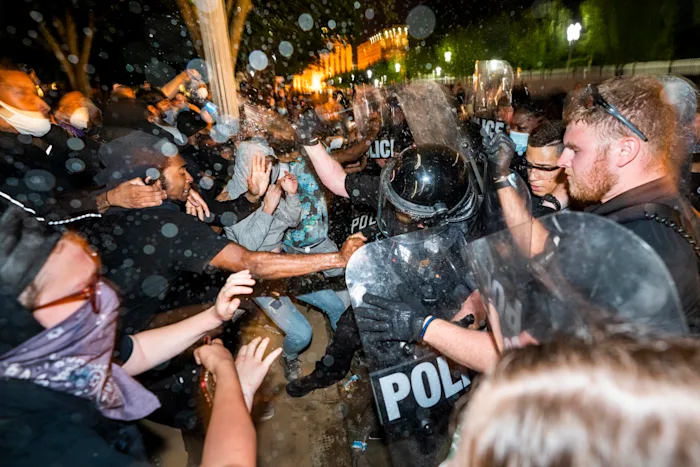
As the liberal-democratic peace was shattered, the ruling classes leveraged all its forces to contain the assault waged upon it. Well-accustomed to siege battles, the police had little trouble sustaining conflicts that were content to remain stationary. Even where they dragged out for quite a while, as in Portland, it is unlikely that the forces of order ever really feared the loss of life or their bases at the hands of the crowd. By contrast, the speed and agility of car looting created unforeseen problems: police would win back one block only to lose another one, and as soon as they pulled out of the first spot, looters would return.41 Unable to fight mano a mano at the scale of the entire city, police were compelled to find another method of projecting their power across the terrain of the city. As a result, the forces of order initiated an unprecedented sequence of infrastructural counter-insurgency. The City of Chicago was truly exemplary in this respect. In response to the second wave of caravan looting between August 10-12th, the cybernetic city was replaced by a Medieval fortress architecture designed to selectively sever its circulatory flows: bridges were raised, city buses were repurposed as mobile barricades and shuttles for riot police, sanitation, trash, and salt trucks were deployed to block roads and highways, concrete barriers lined the shopping districts, etc. The aim was obvious to everyone: to functionally isolate the black population from the rich neighborhoods, to raise the drawbridge between the castle and the wilderness beyond.
Infrastructural counterinsurgency carries risks for ruling powers. As the means of urban reproduction are drafted into the theater of war, the veil of social unity projected by the city during peacetime is torn asunder. In this way, by pushing the police order to react infrastructurally, the car looting completed the unprecedented destitution of the fictions of social peace begun by the initial street battles at the end of May.42 Any pretense of neutrality is withdrawn: police and ruling class politicians close ranks and defend their turf like the gang that they are, public transit is perfunctorily suspended, while Capital’s cities are exposed as little more than a cluster of apparatuses designed to funnel wealth into white neighborhoods while containing the racialized proletariat on which it depends at its margins, included as excluded. This visionary destitution of power marked the outer limit that the 2020 revolt was capable of reaching, nakedly exhibiting both the social cruelty and material fragility on which economic and police power rests. It proved that with enough determination, control of America’s major cities can be wrenched away from police for days on end, while the avenues where the wealthy live can be devastated.
But the ruling class counter-offensive was swift and effective. Once its symbolic centers were stolen away, its posh storefronts locked off or placed under 24 hour police surveillance, insurgents were generally unable to develop effective alternate strategies for continuing the offensive. It has been easy to embarrass power, but hard to defeat it.
It is with this in mind that, stepping back a bit, the twin jets of the political riot and the storefront riot now begin to appear in a different light, almost as if this division (polis and oikos) were two ends of a single apparatus in which the power of the insurgency had allowed itself to become trapped. What would it look like to overcome this apparatus?
According to a certain line of ultraleft thought, what is needed is for the merchandise riot to ascend the supply chain in reverse, for the storefront riot to mutate into an infrastructure riot capable of responding to police logistics by disrupting the circulatory flows on which the economy depends. On this view, short circuiting the arterial web of capitalist circulation by targeting ports, warehouses and factories presents a far greater threat to power than emptying retail outlets in shopping districts. Whence the bated breath around the Breonna Taylor verdict, as materialists fantasized about the riots leaping over themselves and disrupting the UPS WorldPort, a key artery for the regional circulation of commodities.43
Rather than starting from the map of Capital and working backwards, we should ask how the impulses that the movement itself engendered might be extended in new directions. On the one hand, it is undeniable that car looting — to say nothing of the looting of freight trains — already includes within it a certain degree of partisan logistics (encrypted communication, mobile coordination, mastery of the terrain, ingress/egress, etc.), yet one that remains subordinated to the dynamism of the merchandise-riot.44 On the other hand, the occupations of the CHAZ/CHOP in Seattle, the Federal courthouse plaza in Portland, City Hall in NYC all attest to a powerful impulse toward placemaking, yet one whose preferred locations were subordinated to the dynamic of the political riot.45
For the movement to break the apparatus in which its power was captured would mean disentangling the placemaking impulse of the movement from its one-sided inscription in the political riot, and second, extending the logistical intelligence of car looting beyond the form of the storefront riot.
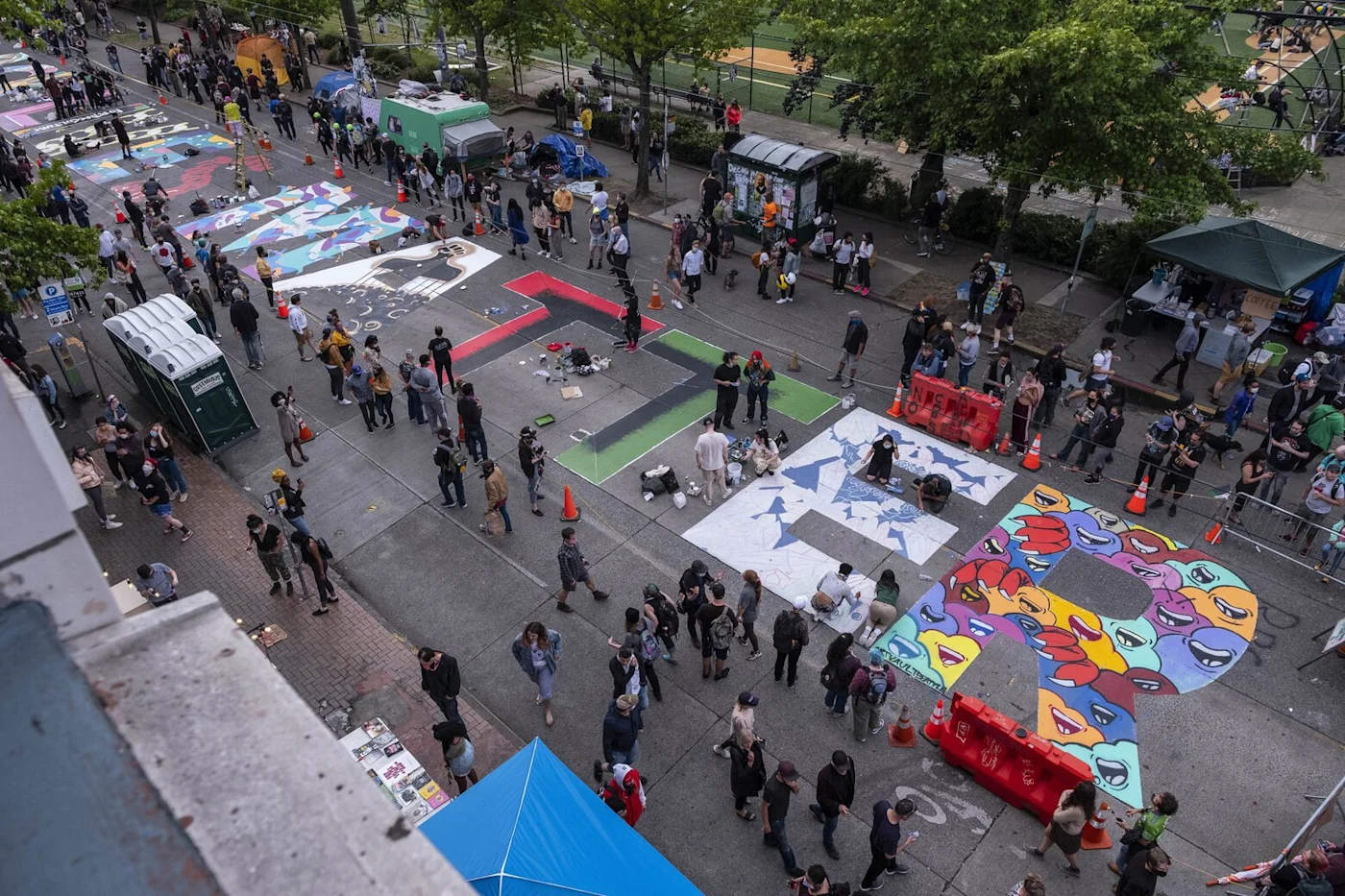
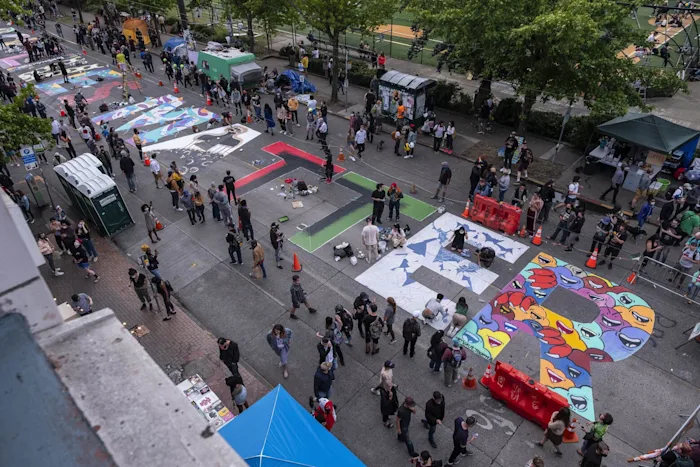
It is possible — if not entirely easy — to imagine frontliner culture, which has been generally constricted to street battles with police, mutating into an antagonism in a more explicitly infrastructural context. During the insurgency against the authoritarian Chinese state in Hong Kong, the dialectic of repression and retaliation escalated to the point where rebel youth declared open season on the city’s public transit system writ large. Four years prior, after the murder of Remi Fraise in France, ZADists teamed up with survivors of police violence to organize a weekend of actions outside a police munitions factory, resulting in fiery demonstrations so dangerous that they shut the factory down for days. While the strength of both approaches lay in aiming their sights past the social enemy toward the infrastructural grids on which its power depends, their weakness lay in the exhausting willpower such attacks require in order to sustain themselves and — in the case of the Nobelsport factory — the remoteness of the terrain from the space of combatants’ everyday life.
In this regard, when it comes to combining logistical initiative with situated placemaking, the unsurpassed model remains the roundabout occupations of the Yellow Vests.46 By embedding themselves in close proximity to the space and time of everyday life, by blocking circulation not at the point of greatest importance to capital but at the point where capital enters the space of everyday life (freeway offramps into towns and cities), they politicized the membrane between life and money on terms amenable to them. The true strategic horizon of hinterland blockades is not to suspend the flows of the economy tout court, but to produce inhabited territorial bases that restore it to the map of everyday life, at a level at which it can be seized upon and decided. As the blockades erected by Oaxacan teachers in 2016 had already demonstrated clearly, successful blockades are selective. The model is not the trench but the filter: enemy corporations are turned back or plundered, while the community is waved on with a smile.47
However, such a leap in the U.S. context would imply a qualitative mutation for which there is no linear path. A new memetic repertoire would be necessary, one that speaks not only to decaying suburbs, but also to the further out hinterlands: occupations of gas stations and toll booths, slow-rolls, the takeover of vacant strip malls, coordinated looting of Amazon warehouses and freight trains, etc. None of this can happen without the movement posing a radically new problem.
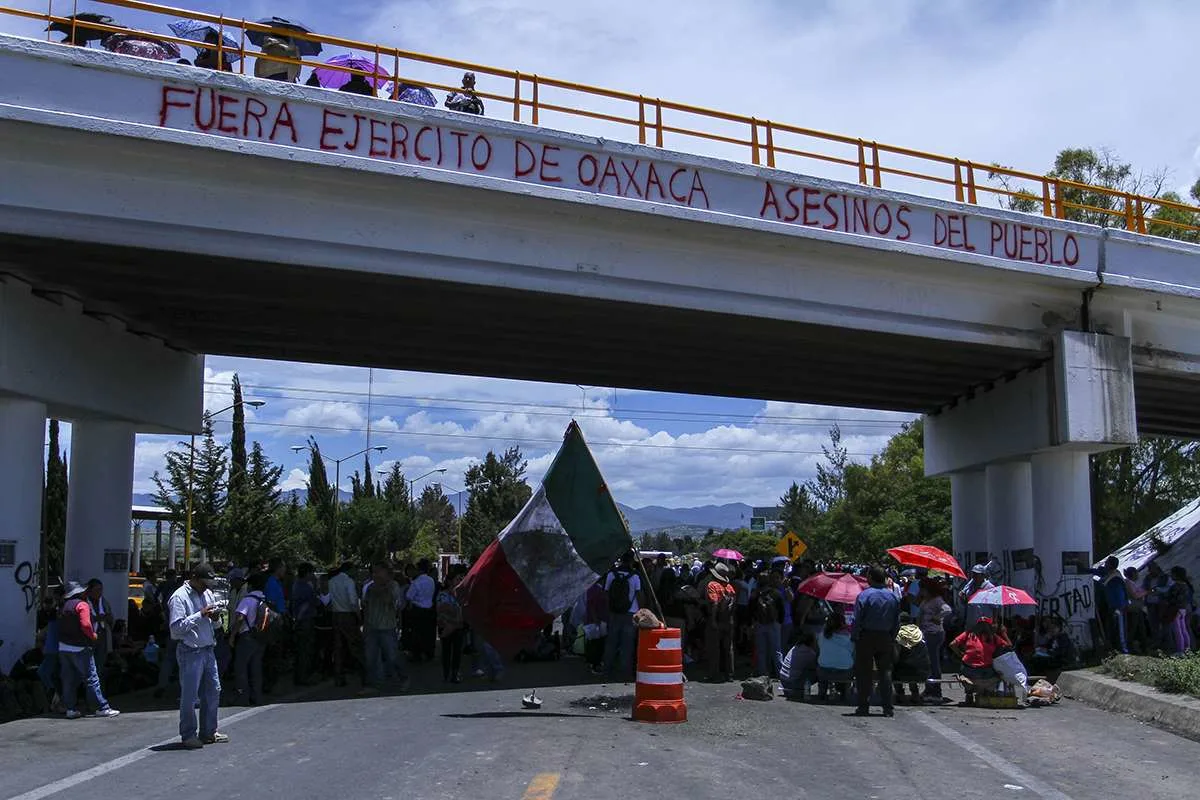
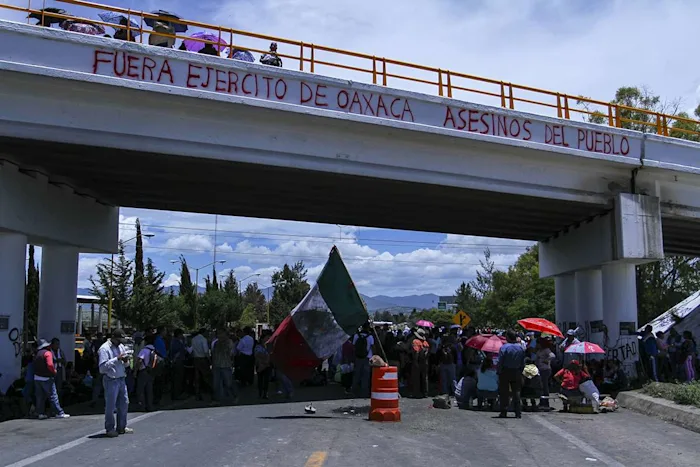
Any choice of terrain is a way of posing a question to ourselves about the nature of the war we are fighting. The problem of logistics, as well as that of place, must be understood from this point of view. There is no inherent connection between the riot, the strike, or the blockade of infrastructure, nor is there a natural or quantitative escalation envisionable that would organically lead from one to the other. Herein we confront one of the ultimate challenges any insurrectional movement must face: how to shift from one frame of war to another, from one image of victory to another, how to change the nature of the conflict, while fighting it? How to not only engage in a conflict, but to wage a “conflict over conflict” from within its midst, thereby posing a new problem?48
Could another rebellion against the police murder of black lives open up the vortex sufficiently wide that capitalist command comes under fire? Is it possible, from within the demolitionist moment, to imagine a second, third, or fourth “rhythmic marker” introducing another dynamic into such revolts, as happened in Chile, when the memetic rebellion initiated by students mutated to absorb the rage of feminists, indigenous communities, anarchists, and other groups, becoming a general antagonism in which the very notion of constituent power itself is up for grabs? 49
Without end
No one needs to be told that this world stands on a precipice. The evidence is everywhere. Yet nothing about the catastrophe through which we are living makes a revolution inevitable. What is decisive is not to denounce or critique, but to study the seams that allow situations to split open, that let antagonisms spread and generalize, restoring motion and confidence to our lives here and now. Contemporary struggles don't expand around ideas or ideologies, but around gestures that make sense of their moment, situated truths worth defending. A million correct ideas about the present are swept away by a single act that alters that reality.
When the intolerable explodes again into a public scandal, everything must be done to push for its irreversibility. How do we pivot from demolitionism to collective experiments in non-monetized sharing? How do we suppress and deactivate the organs of representation that seek to incorporate and disarm us? How do we exit the terrain of the social while creating spaces of communion, desertion, and contact along the way?
While the movement has died back for the time being, the fictions on which social peace rests remain as fragile as ever. Nothing is over. With a lot of tact and a little luck, next time will hit even harder.
May 2021
Notes
1. Paul Torino and Adrian Wohlleben, “Memes with Force: Lessons from the Yellow Vests,” Mute Magazine, February 2019. Online here. An interview with Interchange Radio on the subject is available here.↰
2. “In contemporary insurrections…[the] hierarchical structure of command and its concomitant drive toward unity is being replaced by a form of immanent collective intelligence. Gestures and communication spread across an increasingly fragmented socius without consolidating any coherent organizational body or identity. Actions and tactics, shared on Telegram or social media and detourned to fit the needs of specific locales, spread in a memetic fashion.” Anonymous, “At the Wendy’s: Armed Struggle at the End of the World,” Ill Will, November 2020. Online here.↰
3. Gilles Deleuze and Félix Guattari, Anti-Oedipus. Capitalism and Schizophrenia Vol. 1, translated by Robert Hurley, Minnesota University Press, 315.↰
4. Occupy Wall Street was initially constructed on a memetic platform. The meme was as follows: seize a plaza, set up autonomous circuits of social reproduction, make decisions through consensus, defend the occupation where necessary. In principle, anyone who showed up could take part: there was no “prior” belonging that authorized participation, nor were there central "demands" through which the movement indexed itself to any particular social subject in an a priori way. However, within a matter of weeks the movement had rigorously institutionalized itself: democratic proceduralism, activist virtue signaling, and endless working groups threw it back on itself, directing its energies inward rather than outward. When we showed up at the occupation we were singularities, but to “participate” meant being drafted into constituent compositions modeled entirely on centralized decision making and representational obsessions. Fairly soon, the only moments that felt powerful were when the state took the initiative to evict the occupations, thereby interrupting the democratic echo chamber. From Occupy, we learned two things. (i) The central contradiction today is no longer between vertical and horizontal organizing methods, nor is it between organizing inside or outside of formal institutional channels; all meaningful mass action today is horizontal, and only those movements that begin outside institutions will ever reach the point of constituting a threat. (ii) In fact, the central contradiction is between movements that retain the framework of classical politics — i.e., whose means rely on discourse and dialogue, and whose ends lies in the advancement of symbolic and hegemonic influence within civil society — and those movements that challenge the apparatus of "political speech" and representation by sidestepping any reference to a constituent subject and developing other modes of collaboration and communication. That said, although this basic difference remains decisive, we will most likely continue to see strange amalgams in the coming years. ↰
5. The prefix, “ante-,” is intended to mark the fact that the event of revolt is not sui generis, but mobilizes vital forms that were “already to some extent present” before it. See K.N. and Paul Torino, “Life, War, and Politics: After the George Floyd Rebellion,” Ill Will, November 2020, Part III (online here). An analogous idea lies at the base of what Moten and Harney refer to in The Undercommons as “the surround.” ↰
6. “What is a demand?...[It] is a contract, the guaranteed expiration date of one’s struggle, the conditions for its conclusion.” Johann Kaspar, “We Demand Nothing.” First published in Fire to the Prisons 7, 2009 (online here).↰
7. “It is gestures that use us as their instruments, as their bearers and incarnations.” Milan Kundera, Immortality, 7. ↰
8. By “politics,” we understand those conflicts within everyday life that intensify to the point where sides must be taken, where neutrality is no longer possible. As such, there are no specifically-political gestures or practices (speaking, debating, voting, etc.). The same applies in reverse: all gestures, all practices are potentially-political, or ante-political, including speech — provided, of course, that one speaks from within a polarization, not above it. When a conflict becomes intense enough, previously innocuous gestures and relations suddenly become hyper-potentiated and draw other forms and materials into the vortex. Later, once the conflict subsides, the polarized practices or slogans are either reabsorbed into the banality of everyday life, or else abandoned. ↰
9. “Mass and class do not have the same contours or the same dynamic, even though the same group can be assigned both signs. […] Mass movements accelerate and feed into one another (or dim for a long while, enter long stupors) but jump from one class to another, undergo mutation, emanate or emit new quanta that then modify class relations, bring their overcoding and reterritorialization into question, and run new lines of flight in new directions. Beneath the self-reproduction of classes, there is always a variable map of masses.” Deleuze and Guattari, A Thousand Plateaus, 221.↰
10. To be a bit simplistic, the operative assumption here is that the spread of anarchy or ungovernability offers the most opportune path to opening up a new horizon of mass communist desertion and invention. However, since we cannot know what shape this horizon will take, nor do we wish to succumb to the prophetic trap of ‘waiting for the miracle’, wagers on revolutionary potentiality must at the same time be rooted not in probabilistic projections but in our existing sensible contact with reality, our sense of what dignity and joy look like here and now, in the world that is, not the world that ought to be. ↰
11. On the subject of right wing co-optation of memetic movements, see the article and interview cited above in Footnote 1. ↰
12. Just as the transcendent status of merchandise under the sensory religion of the Spectacle depends in the "last instance" on the capacity of police to project their power far beyond their physical means, looting announces the profane restoration of both goods and cops to the domain of the sensible: henceforth, police are only where they appear, just as goods can be "had" only provided one can transport them or consume them on the spot. By reducing power and consumption to the domain of free use, looting allows the absence of authority to be felt in a way otherwise impossible. ↰
13. Although a full picture of the factors that played into this decision does not yet publicly exist, some specifics are recounted in an early interview with the Liaisons collective. See “‘Everything seems so fragile and powerful at the same time.’ A conversation about the Seattle Autonomous Zone,” The New Inquiry, June 16, 2020. Online here. As the rebellion in Bogota showed, there is no need to accept a forced choice between occupation or demolition. ↰
14. Some months later, Molotov cocktails were thrown into smashed out windows of the city courthouse in Kenosha, WI, but failed to catch; a minor parole office was also put to flame. See Fran, JF, Lane, “In the Eye of the Storm: A Report from Kenosha,” Hard Crackers, September 2020. Online here.↰
15. Phil Neel arrives at a similar conclusion: “Despite appearing as the opposite, the birth of the autonomous zone was itself a product of the movement’s initial suffocation. While it provided a certain spectacular spur to events elsewhere and offered a brief, transformational experience for a small handful of people, it also sealed in stone all the tactical regressions that had already taken shape as the social movement moved in to strangle the real movement beneath. In effect, then, this national rebellion ignited by the signal fire of a burning police precinct saw a symmetrical end to its first act when demonstrators refused to burn another precinct ceded to them by a similar police retreat.” See Phil Neel, “The Spiral,” Brooklyn Rail, September 2020. Online here.↰
16. Tiqqun, “A Beautiful Hell” (2004), Ill Will, March 2021. Online here.↰
17. Tobi Haslett, “Magic Actions. Looking back on the George Floyd rebellion,” N+1, May 2021. Online here.↰
18. Jeanpierre, In Girum, 19. As a particularly thoughtful, if ultimately inadequate, example of such a negative formulation, one might think of Endnotes’ recent description of the revolutionary movements of our times in terms of “non-movements,” following Asef Bayat. See Endnotes, “Onward Barbarians.” Online here.↰
19. Jeanpierre, In Girum, 27-29: “According to the majority of the yellow vests, politics does not derive its consistency in discourse, nor is it first of all a matter of opinions, demands, or programs.” ↰
20. Maurice Blanchot, “Affirming the Rupture” (1968), in Blanchot: The Political Writings, Fordham, 88-89. Incidentally, one finds here one of the first rigorous formulations of a concept of destituent power. ↰
21. Hannah Black, “Go Outside,” Art Forum, December 2020. Online here.↰
22. While none of these examples are free of contradictions, they testify to a persistent tendency among impoverished insurgents of various ethnicities toward “levelling,” “mass desertions” and (according to the Council report to the Governor following Bacon’s rebellion) “Vaine hopes of takeing the Countrey wholley out of his Majesty’s handes and into their owne.” See Howard Zinn, A People’s History of the United States, Harper Collins, 2005, 41-42. ↰
23. Kiersten Solt, “Seven Theses on Destitution (After Endnotes),” Ill Will, February 2021. ↰
24. Maurice Blanchot, The Unavowable Community, Station Hill, 16.↰
25. Keno Evol, “Daunte Wright: A Billion Clusters of Rebellion and Starlight,” Mn Artists, April 2021. Online here.↰
26. David Galula, Counterinsurgency Warfare: Theory and Practice, Praeger, 1964, 95.↰
27. Laurent Jeanpierre, In Girum. Les leçons politiques des ronds-points, La Découverte, 2019, 19. ↰
28. As Phil Neel notes, it matters little whether the Leftists who enact this substitutional repression are conscious of their true political role or not, or whether they work explicitly with the police or not. The fact that “they earnestly see themselves as advancing the movement, even as they stifle it” makes the operation all the more effective. See Phil Neel, “The Spiral.”↰
29. “Thus did Las Casas and the planters come to terms. At daggers drawn over the labor of the Indian, they saw eye to eye on the labor of the Negro […] Justice to the Indians was purchased at the price of injustice to the Africans. The belligerent Protector of the Indians became a benevolent promoter of Negro slavery and the slave trade.” Eric Williams, From Columbus to Castro (1970), p.43. Although Las Casas later regretted his suggestion, Williams notes that his regret still retained an anti-Black grammar, emphasizing an “empirical error” about African physiognomy rather than a lapse in universal moral judgment about the dignity of all life. ↰
30. Bartholomé de Las Casas was a Spanish settler who later used his position as a religious figure to attempt to halt (or, where this proved impossible, to remediate) the tide of genocidal violence unleashed on Native Americans during the first phases of the colonization of Central America. In his audiences with the King he adopted a strategic approach, challenging not the legitimacy of the Conquest per se but its methods, insisting on the moral and material-financial urgency of introducing order and oversight into the colonial missions that he hoped would check the wanton violence of the settlers. In this, he may be regarded as an early progenitor of projects such as police oversight committees and other policy reforms intended to curb state violence without deposing it. At the same time, Las Casas was also among the first Europeans to advocate the "just cause" of an armed war for self-determination on the part of the ‘Indians’, and for this he has long been regarded as an early progenitor of decolonial and abolitionist politics. Whether one prefers to emphasize his role as a colonizer, a humanist reformist, or a partisan of decolonization (or an amalgam of all three), what is certain is that, in his budding awareness that “civilization is not a singular but plural,” in his sensitivity to the “discontemporaneity of historical developments and the relativity of the European position” (as Enzensberger once put it), Las Casas was not only the first truly modern subject, but the figure who best exemplifies the apparatus through which modern political consciousness covers over this knowledge through its moral subsumption of alterity, and the ruse of analogy by which modernity attempts to govern its own outside. (Citation taken from Hans Magnus Enzensberger, "Las Casas, or a Look Backwards into the Future," Zig Zag: The Politics of Culture and Vice Versa, The New Press, 1998, 90-93). ↰
31. Lawrence Clayton, “Bartolomé de las Casas and the African Slave Trade,” History Compass 7/6, 2009.↰
32. Ronald Judy, (Dis)forming the American Canon: African-Arabic Slave Narratives and the Vernacular, Minnesota, 1993, 81. ↰
33. Judy, (Dis)forming the American Canon, 83: “Thinking, as a part of man's essence, is held to be that which enables the distinguishing of good from evil, but it does so according to a universal order that translates the prima praecepta logically into secondary precepts that function as the basis for all codes of social behavior” (emphasis added).↰
34. This analogy lays the groundwork for the “intra-Settler ensemble of questions foundational to [the West’s] ethical dilemmas (i.e. Marxism, feminism, psychoanalysis).” Frank B. Wilderson, Red, White, and Black: Cinema and the Structure of U.S. Antagonisms, Duke, 2010, 215-219.↰
35. Wilderson, Red, White, and Black, 219.↰
36. The effort to place a rehabilitated vitalist politics in the service of an antifascist and anticapitalist youth movement has precursors not only in the indiani metropolitani of the Italian Autonomia movement (and perhaps already with the circle around Cesarano a decade prior), but also in American revolutionary groups of the ‘60s and ‘70s, such as MOVE and Up Against the Wall / Motherfucker. On left wing versus right wing vitalisms, see Alberto Toscano, “Vital Strategies,” online here.↰
37. Sonali Gupta and H. Bolin, “Virality. Against a Standard Unit of Life," e-flux, February 2021. Online here.↰
38. In one of the finest texts produced last summer, “The Siege of the Third Precinct of Minneapolis: An Account and an Analysis” (CrimethInc, June 2020), both dynamisms are theorized solely from the point of view of the agenda of the political riot. While the theory of composition offered in this text came the closest to describing the organizational animus ‘on the ground’, it was too quick to subsume all aspects of the situation into a single type of crowd. According to the authors, the central feature that allows “looters” to be counted as a "role" within the composition of the political riot’s crowd (medics, ballistic squads, laser pointers, sound systems, communications, etc.) is the fact of contributing to a general “ungovernability” of the situation as a whole. While this is understandable given the restricted frame of the article, which sought to map out the constellation of forces that led to the burning of the Third Precinct, from the point of view of a broader theory of the insurgent "crowd" in the 21st century it seems important to recognize the difference in kind between the two dynamisms at the level of their targets, motion, orientation toward the enemy, etc. The political riot to the storefront riot remain separate types of crowds: even when they coexist on two sides of the same parking lot, as at the Target opposite the Third Precinct, to pass from one to the other involves a mutation and a becoming, a “tightening” and “loosening” as Elias Canetti said.↰
39. Of course, many local variations occur; sometimes the one riot dominates to the exclusion of the other. For instance, Portland’s long summer was marked by an extremely sustained political riot with few if any occasions of looting, whereas the storefront riots in Chicago took place without any attacks on state property or stationary clashes between crowds and police. ↰
40. On the distinction between “good” and “bad” rioters, see Nevada, “Imaginary Enemies: Myth and Abolition in the Minneapolis Rebellion,” Ill Will, November 2020. Online here. Where the state doctrine speaks of “good” and “bad” rioters, we speak of political riots and storefront riots.↰
41. Shemon and Arturo have contributed an admirable analysis of the use of car looting after Walter Wallace’s killing in Philadelphia. See Shemon and Arturo, “Cars, Riots, and Black Liberation,” Mute, November 2020. Online here. However, I would add that the genealogy of vehicular warfare is by no means limited to struggles around black liberation. From the slow-rolls of "Black Smoke Matters" to the 3000-strong motorcycle and moped swarms during the uprising in Puerto Rico, to the volunteer taxi mobs that spirited demonstrators out of harm's way in Hong Kong, the tactical deployment of personally-owned vehicles has became an increasing feature of the global grammar of action. While each of these cases represented tactical innovations in the mobilization of privately-owned vehicles as a force of intervention, where their weaponization is concerned, it seems to me that a certain sequence begins in 2016 when, during height of the clashes at Standing Rock, personal vehicles were transformed into barricades to block the main road to the DAPL construction site, before later being set on fire when police moved to attack the protesters who defended them. A year later, the right wing offered its reply to Standing Rock, when James Fields deliberately drove his car into a crowd of antifascists in Charlottesville in 2017, murdering Heather Heyer. Since then, vehicles have become a permanent tactical and affective element in street level conflicts, from sideshows and Covid caravans to the first failed appearance of flotillas among Trump supporters. Nothing is more American than dragging everything in one’s garage to the demo with you.↰
42. The concept of destitution was glossed in a letter published on Ill Will last year: “On the one hand, [destitution] refers to the emptying-out of the fictions of government (its claim to universality, impartiality, legality, consensus); on the other hand, it refers [to] a restoration of the positivity and fullness of experience. The two processes are linked like the alternating sides of a Möbius strip: wherever those usually consigned to existing as spectators upon the world (the excluded, the powerless) instead suddenly become party to their situation, active participants in an ethical polarization, the ruling class is invariably drawn into the polarization and cannot avoid exhibiting its partisan character. The police become one more gang among gangs.”↰
43. As Shemon and Arturo have recently observed, there is a “clear limit between the between the riot and the [logistics] strike,” such that may simply be unrealistic to expect BLM as a mode of action to authorize or invite a leap to the level of industrial actions at factories, warehouses and ports. See Shemon and Arturo, “After the Tear Gas Clears,” It’s Going Down (podcast interview), online here. The Wendy’s in Atlanta is an outlier in this series, since its choice of locations obeyed neither of the two horizons indicated here; it seems to have had no horizon other than itself.↰
44. This fact is occasionally observed by ruling powers as well. As Chilean President Sebastián Pinera declared, “We are at war against a powerful enemy […] We are very conscious that they [protesters] have a degree of organization and logistic that is characteristic of a criminal organization” (Public address October 20th, 2019).↰
45. The occupation of the Wendy’s in Atlanta is the outlier in this sequence, taking place in a poor and largely Black neighborhood, far from both the halls of power and the storefronts.↰
46. On this point, see the discussion of destitution and place in Wohleben and Torino, “Memes with Force” (footnote 1)↰
47. As a middle school teacher explained to NPR at the time, “[we let through] cars, but not trucks hauling goods for major corporations like WalMart and Coca-Cola.”↰
48. On this point, see K.N. and Paul Torino, “Life, War, Politics,” Ill Will, November 2020. Online here. Among the best examples of the difficulty at stake in waging a "conflict over conflict" is the effort by residents of the ZAD in Notre-dame-des-landes, France to shift the frame of their struggle after the state handed them a victory and canceled the airport they were blocking. See Mauvaise Troupe, “Victory and its Consequences” (2019), The New Inquiry, May 2020. Online here.↰
49. On the Chilean revolt and the idea of “rhythmic markers” by which it was able to expand, see Rodrigo Karmy Bolton, “The Anarchy of Beginnings. Notes on the Rhythmicity of Revolt,” Ill Will, May 2020. Online here. It’s worth noting that Karmy’s concept remains ambivalently situated between the Trotskyist problem of a “convergence of struggles,” which he evidently wants to avoid in his thinking of the event, and another viral image of politics for which he does not yet have a name. Far from a theoretical failing, this ambivalence is simply the structuring dilemma of our epoch. ↰